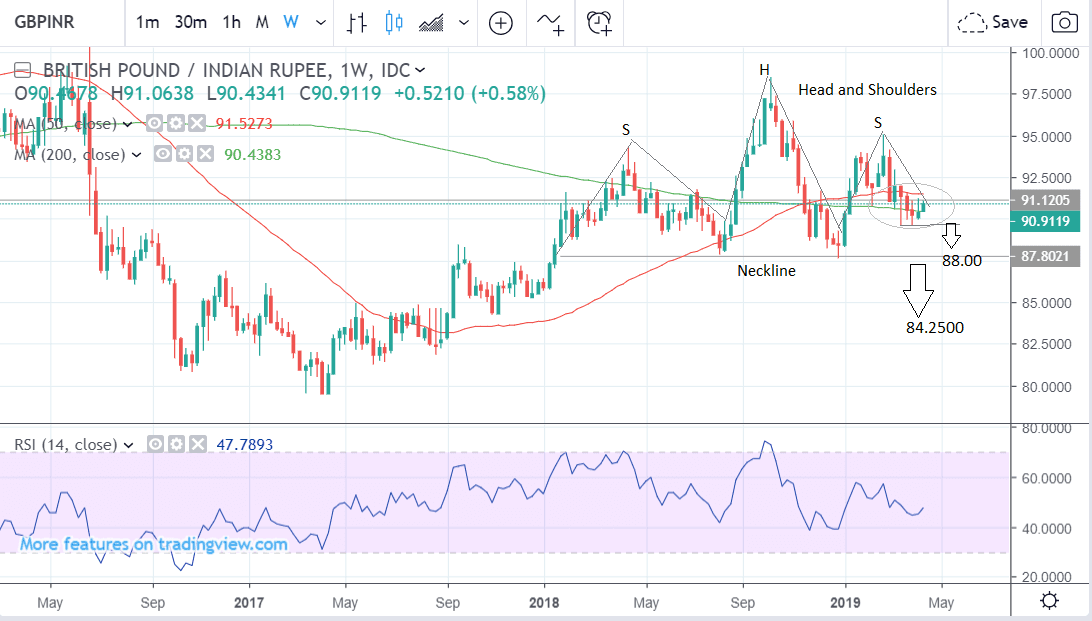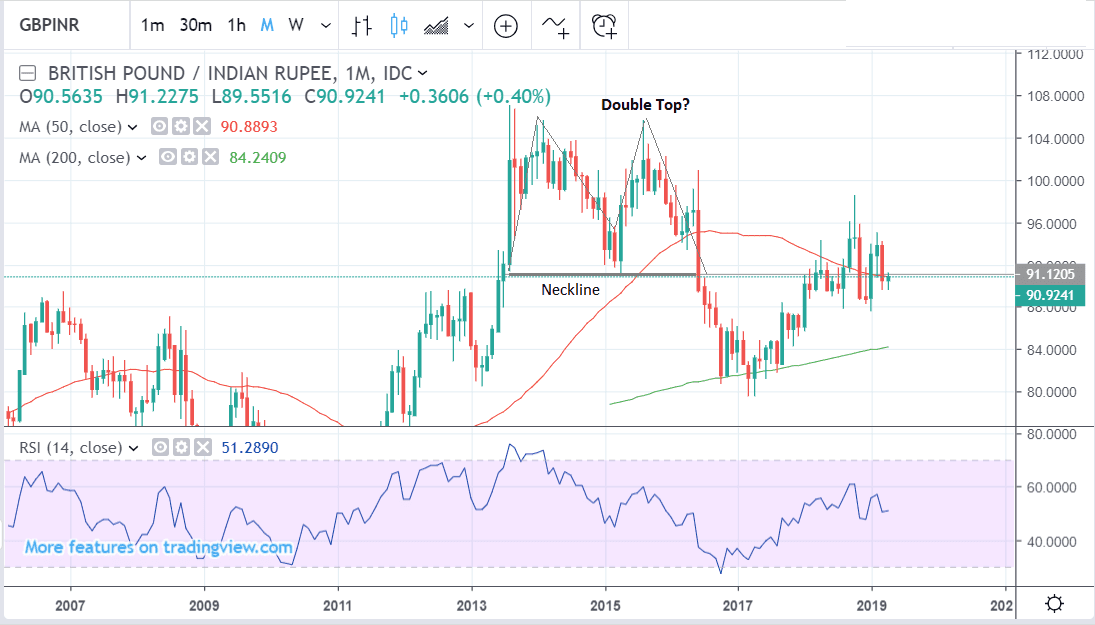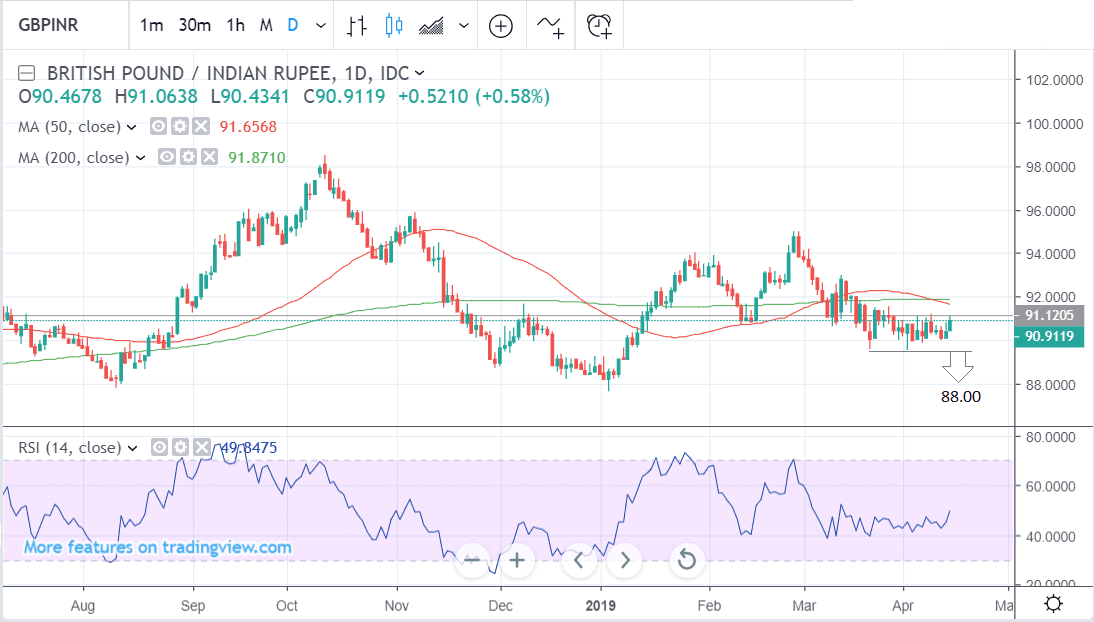Pound-Rupee Rate at Major Support Level, Further Declines Seen in the Forecast
- GBP/INR in downtrend with bearish pattern
- Break below 88.00 ‘neckline’ key to extension lower
- RBI minutes could influence Rupee trade this week
The Pound still appears to be in a short-term downtrend against the Indian Rupee following its decline all through March and given the old adage that ‘the trend is your friend’ we see more downside in GBP/INR on the horizon as the more probable development over the short-term.
From a technical perspective, the near-term outlook is bearish now the pair has formed a large head and shoulders (H&S) bearish reversal pattern on the weekly chart.
The H&S is composed of a higher high: ‘the head’ and two slightly lower peaks either side: ‘the shoulders’. The neckline connects the intervening trough lows and is used as a confirmation level. If the exchange rate can break below, it confirms more downside.
A break below the neckline which is situated at 88.00, would green-light a deeper decline down to a target at roughly 84.25 at the level of the 200-month MA, a key support level for the pair.
The exchange rate has not yet reached the neckline and is currently being supported by the 200-week MA in the 90.90s. This would first have to be broken before expecting more downside.
A clear break below the 89.60 March 21 lows would confirm clearance and open the way down to the next target at the 88.00 neckline. A break below that would then provide the go-ahead for deeper declines.
The daily chart shows the pair in a short-term downtrend through March but otherwise rather non-directional.
Recently the market has plateaued, and a clear break below the 89.60 lows would be required for bearish confirmation.
Time to move your money? Get 3-5% more currency than your bank would offer by using the services of foreign exchange specialists at RationalFX. A specialist broker can deliver you an exchange rate closer to the real market rate, thereby saving you substantial quantities of currency. Find out more here. * Advertisement
The Indian Rupee: Fundamental Factors to Watch Over Coming Days
Wholesale inflation data showed a much higher than expected reading in March, rising by 3.2% from the 2.9% previous month’s figure, according to data out on Monday April 15, and this could provide positive support to the Rupee if it is seen to feed into higher consumer prices.
The data could impact on expectations of whether the Reserve Bank of India (RBI) will continue cutting interest rates if it filters through into core inflation.
Yet at the same time, this is unlikely to happen quickly enough to dissuade the RBI from cutting interest rates at their June meeting, according to analysis from Capital Economics.
The wholesale price data showed food inflation rose even more strongly than overall wholesale prices, going up by 3.9% from a previous rate of only 3.3%.
This could possibly impact on Nahrendra Modi’s election prospects, as stagnant farmer incomes, driven in part by subdued food inflation, had led to a rural backlash against the government. If food prices rise, therefore, and farmers begin to benefit they may have more sympathy for Modi’s government.
Whether this will happen in time for the elections, however, is questionable, since they already started on April 11 and will be over by May 19, nevertheless, the data alone may impact rural voter sentiment, or be indicative of a more benign backdrop.
According to the last poll published on April 8 Modi’s NDA party were forecast to gain an outright majority of 7 seats. If he wins it will probably be positive for the Rupee given markets like his reformist agenda. We covered the Indian election in more detail in last week’s article on the Rupee.
Trade data out on Monday, April 15 showed a decline in the trade balance further into deficit than had been forecast, suggesting negative knock-on effects for the Rupee.
The trade deficit fell to $-10.9bn from $-9.6bn when a fall to only $-10.3bn had been forecast. Increases in the trade deficit often correlate with weaknesses for the currency. The deepening deficit was mostly caused by the rise in the price of oil, which India has to import vast quantities of since it has little oil of its own. Indian oil imports rose 5.55% in Dollar terms in March (12% in Rupee terms) whereas non-oil imports actually fell during the same period.
The next major release for the Rupee is the minutes of the last monetary policy meeting of the RBI on April 4. At the meeting the Bank lowered the benchmark by 0.25% to 6.00%, because of falling inflation and inflation expectations.
The minutes will provide more information about the deliberations of the monetary policy committee and can indicate whether there is a willingness for further cuts or not, thus helping the market position for such an inevitability.
Time to move your money? Get 3-5% more currency than your bank would offer by using the services of foreign exchange specialists at RationalFX. A specialist broker can deliver you an exchange rate closer to the real market rate, thereby saving you substantial quantities of currency. Find out more here. * Advertisement



